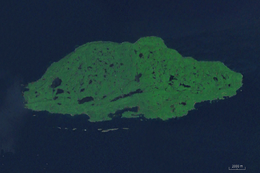
Back Michipicoten Island CEB Michipicoten Island German Île Michipicoten French Michipicoten Island Swedish
 Landsat view of the island. | |
 | |
| Geography | |
|---|---|
| Location | Lake Superior |
| Coordinates | 47°45′N 85°45′W / 47.750°N 85.750°W |
| Area | 184 km2 (71 sq mi) |
| Administration | |
Canada | |
| Province | Ontario |
| District | Thunder Bay District |
| Demographics | |
| Population | Seasonally variable |
| Michipicoten Island Provincial Park | |
|---|---|
| Area | 36,740.00 ha (141.8539 sq mi)[1] |
| Designation | Natural Environment |
| Established | 1985 |
| Governing body | Ontario Parks |
| www | |
Michipicoten Island is an island in Ontario, Canada, in the northeastern part of Lake Superior, about 175 kilometres (109 mi) northwest of Sault Ste. Marie and 65 kilometres (40 mi) southwest of Wawa, Ontario.[2] At its closest point to mainland Ontario, the island is located about 16 kilometres (9.9 mi) from the mainland.[2] It falls within the boundaries of Thunder Bay District. The third largest island in Lake Superior, after Isle Royale and St. Ignace Island,[3] Michipicoten Island is 27 kilometres (17 mi) long and 10 kilometres (6.2 mi) wide at its widest point.
Most of the lands of Michipicoten Island, as well as smaller islands, shoals, and waters which surround it to within 2,500 metres (1.6 mi), were regulated as Michipicoten Island Provincial Park in 1985.[4][5] Despite attempts to develop a comprehensive park management plan in the early- to mid-2000s,[6] it continues to be administered by Ontario Parks[7] under an interim management statement developed in 1986.[8]
During the spring, summer, and fall, the island is inhabited or regularly visited by the owners of camps located on a small number of private inholdings, commercial fishers,[8] and clients of a commercial outpost camp.[9] It has become a destination for some adventurous kayakers. In the winter, due mainly to reasons of remoteness and difficulty of access, the island is usually uninhabited.
Michipicoten Island has plentiful wildlife (notably beaver, woodland caribou, and birds). It is located in the Great Lakes-St. Lawrence Forest region.[10]
The island is made up of ancient lava bedrock related to volcanism of the Midcontinent Rift System[3] and is heavily forested, with over 20 inland lakes. It has a rugged interior, containing east-west aligned ridges with gentle southern slopes and steep northern slopes. The highest point is 298 m (978 ft) above Lake Superior.[11]
A lighthouse was established in 1912 on the eastern end of the island. It was staffed until 1988.[12]
On some old maps, Michipicoten Island is shown as Isle Maurepas, after the French minister of Marine Jean-Frédéric Phélypeaux, Count of Maurepas.[13] The word Michipicoten is an Anglicization of the original Ojibwe word Mishipikwadina, meaning "big bluffs" in Ojibwe, and is a reference to the geography of the nearby Michipicoten River.[14]
Mishipeshu, a powerful creature in the traditional beliefs of some Native American tribes―particularly Anishinaabe tribes, the Odawa, Ojibwe, and Potawatomi, of the Great Lakes region of Canada and the United States―is traditionally said to make his home on Michipicoten Island.[15][16]
- ^ "Michipicoten Island". www.ontarioparks.com. Ontario Parks. Retrieved February 16, 2022.
- ^ a b Ontario Ministry of Natural Resources (2004). Michipicoten Post and Michipicoten Island Provincial Parks Management Planning: Background Information (PDF). Queen's Printer for Ontario. ISBN 0-7794-6544-X. Retrieved April 18, 2014.
- ^ a b Ontario Ministry of Natural Resources (July 2, 2013). "Natural Heritage Information Centre". Queen's Printer for Ontario. Retrieved April 18, 2014. [permanent dead link]
- ^ "Michipicoten Post and Michipicoten Island Management Plan EBR Registry Number: PB03E2004". Environmental Registry of Ontario. August 9, 2004. Archived from the original on September 5, 2017.
- ^ "Michipicoten Island Provincial Park". Ontario Regulations (PDF). 1985. p. 260. Archived from the original (PDF) on September 5, 2017.
{{cite book}}:|work=ignored (help) - ^ https://www.ebr.gov.on.ca/ERS-WEB-External/displaynoticecontent.do?noticeId=MjAzMDM=&statusId=MjAzMDM=&language=en
- ^ "Welcome to Michipicoten Island Provincial Park".
- ^ a b "Michipicoten Island Provincial Park Management Statement | ontario.ca". www.ontario.ca. Retrieved January 20, 2024.
- ^ "Michi - Hawk Air". October 23, 2021.
- ^ J. S. Rowe. "Forest regions of Canada" (PDF). gc.ca. Retrieved January 20, 2024.
- ^ "Michipicoten Post and Michipicoten Island: Background Information" (PDF). Ontario Parks. 2004. Archived (PDF) from the original on June 11, 2011. Retrieved December 21, 2019.
- ^ "Michipicoten Island East End Lighthouse".
- ^ Schwartz, Seymour I. (2008). The Mismapping of America. Rochester, NY: University of Rochester Press. pp. 192–195. ISBN 9781580461290.
- ^ Kelton, Dwight H. (1889). Indian Names and History of the Sault Ste Marie Canal. Detroit: Detroit Free Press Printing Co. pp. 24–5.
- ^ Conway, Thor (2010). Spirits in Stone. Sault Ste. Marie, Ontario: Heritage Discoveries.
- ^ Kohl, Johann (1859). Kitchi-Gami: Life Among the Lake Superior Ojibway. ISBN 0-87351-172-7.
© MMXXIII Rich X Search. We shall prevail. All rights reserved. Rich X Search